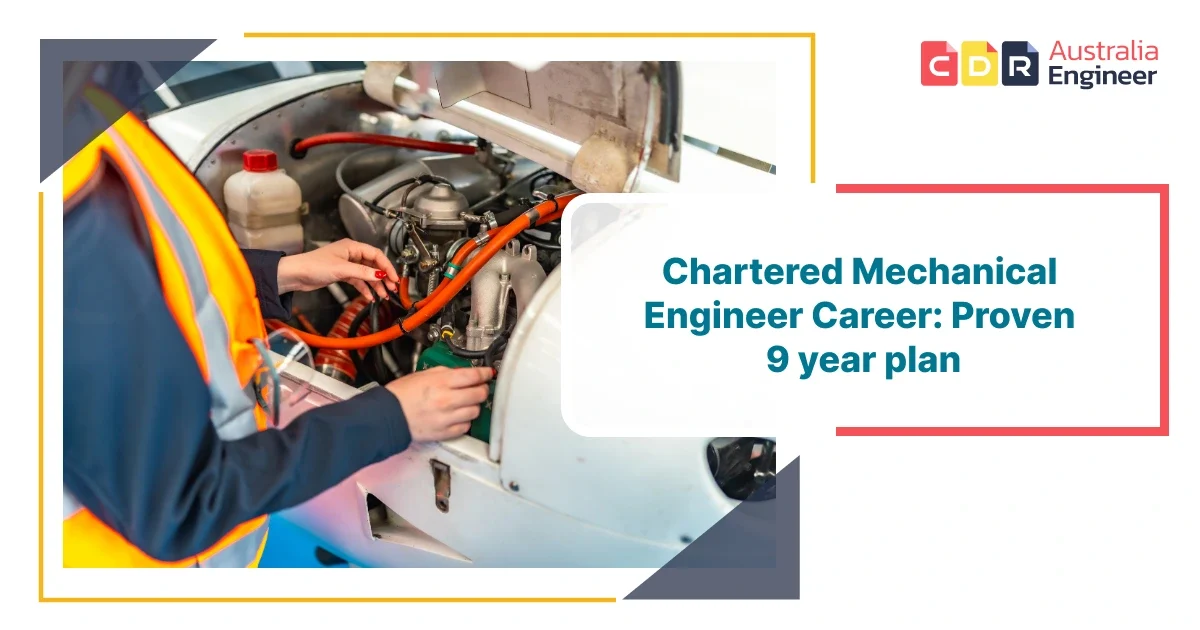

As a fresher mechanical engineer in Australia—or someone planning to move here—starting with a clear Chartered Mechanical Engineer Career Plan helps you build the foundation needed to achieve chartered status in the future. Instead of waiting until you have years of experience.
This roadmap guides you from your first job: developing core technical skills, gaining project exposure, understanding Engineers Australia competencies, and preparing documents like CDRs, RPLs, skills assessments, and resumes as you grow in your career. By following this path early, you can progress smoothly into roles with greater responsibility and leadership potential. Support services such as CDR, RPL, VETASSESS, and resume writing can help you stay aligned with chartered requirements throughout your journey.

Your chartered mechanical engineer career plan starts before you worry about titles like “senior” or “lead.” First, you need a solid mechanical base. Your early foundation usually includes:
Requirement | Details/Examples |
Education | Recognised degree in mechanical engineering or a closely related field |
Technical Knowledge | Thermodynamics and heat transfer, Fluid mechanics and pipe systems, Machine design, strength of materials, rotating equipment, Control basics and instrumentation |
Practical Exposure | Workshops, factories, process plants, building sites, Internships, graduate rotations, or trainee roles |
Professional Knowledge | Basic understanding of Australian safety laws, standards, and professional ethics |
At this stage, your goal is simple: see how real equipment works. Watch pumps, compressors, HVAC units, conveyors, boilers, or production lines in action. The more you link your calculations to actual machines, the stronger your plan becomes
Once you have your basics, your Chartered Mechanical Engineer Career Plan should push you from “junior doing tasks” to “engineer people rely on.”
Phase | Skills/Focus Areas | Details/Examples |
Technical Depth | Equipment selection & sizing | Pumps, fans, heat exchangers, valves, ducts, pipes |
3D modelling & drafting | SolidWorks, Inventor, AutoCAD, or similar | |
Basic simulation/analysis | FEA, CFD, or relevant vendor tools | |
Applying Australian Standards | Reading and implementing standards in projects | |
Project & Communication Skills | Writing technical documents | Emails, reports, commissioning notes |
Explaining to non-engineers | Operators, clients, managers | |
Task planning | Estimating time, meeting deadlines | |
Professional Development | Attend events, webinars, short courses | |
Engineers Australia membership | Start CPD log and maintain records | |
Project documentation | Keep records of projects and personal responsibilities |
At this point, services like Resume Writing Services can help you present your growing responsibilities clearly to Australian employers, and CDR Services can help you start shaping your key projects into future Career Episodes.
By now, your Chartered Mechanical Engineer Career Plan should be moving you into roles where you are accountable, not just “helping.” You might be:
For Engineers Australia, your experience now needs to show that you can:
This is the ideal time to:
At CDRAustraliaEngineer, we’ve helped hundreds of mechanical engineers from India, Nepal, the USA, and other countries map their careers, prepare CDRs, and align their experience with Engineers Australia’s chartered competencies.
CDRaustraliaengineer specialises in high-quality CDR pathway reports for engineers. We offer low-cost, customised, and reliable services tailored to meet Engineers Australia’s standards.

CDRAustraliaEngineer offers Chartered Mechanical Engineer career guidance and EA services, including personalized 9-year career roadmaps, customized Engineers Australia skill assessment support, and strategies to achieve chartered status.
In the final part of your 9+ year chartered mechanical engineer career plan, you are no longer only “collecting experience.” You are:
Chartered status signals that you meet a recognized standard of competence and professionalism. It supports better salary negotiations, more secure roles, and a stronger reputation in your industry.
Start following the career path of a chartered mechanical engineer: gain relevant experience, develop your presence to meet the Engineers Australia expectations, and increase your earning potential.
Overseas mechanical engineers from Nepal, India, the USA, or other countries may need to have their skills and experience formally assessed in order to have them recognized by Engineers Australia and to have a streamlined path towards chartered status.
With the clear pricing and tailored support service from CDRAustraliaEngineer, you can make the transition from mechanical to chartered mechanical engineer inquiry—with less stress and more confidence for as long as you are continuing to be active and involved in your planned career
Q. What is a good career plan for a chartered mechanical engineer?
A career plan that illustrates your technical development, projects, and CPD in relation to the standards of competency set by Engineers Australia.
Q. Why does a career plan help you become chartered sooner?
It keeps you directed towards ensuring you progress with the right experiences, so you meet EA’s competencies in the shortest time, without wasting years on a path that is unrelated to attaining chartership.
Q. What early habits help future chartered engineers?
Keeping project records, reflecting on lessons learned, and doing regular CPD from the first year of work.
Q. Why is documentation important in this journey?
Good documentation makes your CDR, or chartered application, easier, more accurate, and more credible.
Q. Can mid-career engineers still build a chartered plan?
Absolutely—your existing experience can be mapped, refined, and aligned to reach chartered status smoothly.
This guide provides general information only. Always refer to Engineers Australia’s official requirements and seek professional migration or legal advice for your specific situation.